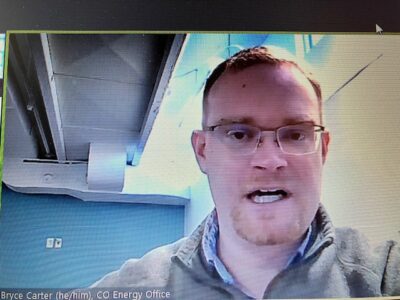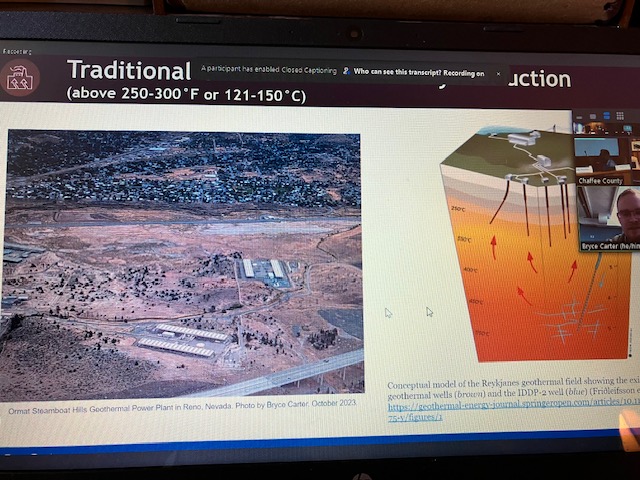During a Chaffee Board of County Commissioners (BoCC) work session this week the BoCC held a discussion with Colorado Energy Office Emerging Markets Program Manager Bryce Carter, to gain a better understanding of the state’s geothermal programs. Geothermal energy is a low-carbon energy alternative being encouraged by Western governors, including in this state, where Governor Jared Polis’s “Heat Beneath our Feet” initiative has been announced.
“We thought we could benefit from some discussion so we have a good feel of how the chessboard is arranged before us,” said BoCC Chair Commissioner Keith Baker.
Carter explained that the department he leads is the funding arm for new energy exploration. “We have a $5 million grant program with $2 million allocated to assessing geothermal resources,” he continued. “This program closes January 19, 2024 and come April there is another opportunity from HB 23 -1272 [a new tax policy that advances decarbonization] that would go toward encouraging geothermal electricity production sources.”
In the past year, in line with Polis’s energy goals, the Colorado Oil & Gas Conservation Commission became the Colorado Energy and Carbon Management Commission (ECMC), which is the state’s regulatory body for oil, gas, and other energy exploration.

Bryce Carter, CEO of the CO Office of Energy explained the state’s focus on geothermal energy in a Chaffee BoCC work session in December, 2023
Carter confirmed that Geothermal resources from surface to 2,500 feet, or resources which involve tributary water resources, are facilitated by the Department of Water Resources.
“Anything deeper [in the range of 15,000 to 20,000 feet] is the state’s renamed Energy and Carbon Management Commission [a division of DNR]. It could go as deep as 25,00o feet. There is some overlap in certain cases.”
He added, “ECMC feels that they shouldn’t be regulated as much as oil and gas. DNR is looking at the pumps — and the intersection between both agencies.”
Carter went on to outline the use of air-source heat pumps, saying “The role of geothermal could play a pretty significant role in mountain towns. Our first grant program is showing us how these technologies could play out in the state.”
Background on Local Conflict
A group known as Mt. Princeton Geothermal LLC has been exploring the idea of a geothermal energy concept in an area of Chaffee County east of Mt. Princeton, but it is on state land and its permit to develop a proof of concept exploration is with the state and has not involved the local government.
This activity has generated intense public comment, some of it highly disrespectful and much of it negative and aimed inaccurately at the BoCC.
Ark Valley Voice has covered geothermal energy for the past year, beginning with a January 2023 meeting attended by state and local officials, as well as energy producers and distributors. The key takeaway from the session: energy producers such as Tri-State Generation & Transmission are watching this, but someone is going to need to invest in the proof of concept at an investment of several million dollars, and it won’t be the producers or distributors.
Throughout the summer AVV attended community and information meetings and addressed the facts and the fallacies about geothermal energy. We recently covered an information session organized by the principals of Mt. Princeton Geothermal LLC.
Discussion Highlights with the Colorado Energy Office
“There is some real interest in how this could play out in this valley, depending on funding we could see a 1041 permit in this valley,” said Commissioner Greg Felt.”Would your office play a role in the way that DNR would?”
“Not necessarily,” responded Carter. “We’d look at a proposal based on the technical aspects of this for a 1041 [permit] — the intersection of geothermal. We want to be of assistance, but make sure we have no conflicts of interest. We could assist with your opportunities as a guinea pig knowing other communities see this.”
“So, as far as the 2,500 ft. line of demarcation, is there an assumption that there isn’t really tributary groundwater below 500 feet,” asked Felt.
“It depends. Some have said this is arbitrary,” said Carter. “Below that generally, you aren’t interfering with the water table … DNR would have a role as well. Everyone wants to do this right, and to make informed decisions … it will definitely be a collaborative agency approach.”
He explained that the geology of each site has unique characteristics and that ultimately the DNR and the ECMC would have to work collaboratively with the U.S. Department of Energy on regulating any proposed exploration. “It is believed there is a deep resource of heat in the valley … that’s what a test well would do, to help determine its potential. There are plenty of opportunities for good neighbor agreements,” he added. “There are ways to set up protections for the public too.”
“First, for this nascent commercial concern here in the valley that is interested in pursuing this, will they be the grant-seeking entity?” asked Baker. “Is there outreach related to that?”
Carter responded that he has had limited interaction with the Mt. Princeton Geothermal group but, “Whoever is the lead applicant … this has a lot of emergent technologies… we want to make sure whatever they do they engage local governments and utilities.”
“Compared to geothermal projects of several years ago, is there any long-term threat analysis of subterranean cooling or other factors?” asked Baker. “Are there long-term consequences for us to consider when or if a 1041 comes along?”
“From a policy standpoint, talking with stakeholders, the pressure situation like you all have here — you take water out, you put water in,” responded Carter. “There isn’t an extraction of the resources, that minimizes the risk factors … and there is monitoring of the resources. In terms of degradation of the key resource – hot water — there is a natural degradation over decades.”
“In Reno, a hotel has been using the heating of geothermal for a few decades, and they have lost two degrees over that time from a single well. The scale is minimal loss… if there is unexpected degradation that’s where the good neighbor agreements come into play,” explained Carter.

Air view of the Reno geothermal source. Photo by Bryce Carter.
He added that this project is a good example of what might work in this valley. He noted that emergent technology such as heat pumps, or capturing heat from solar radiators and sequestering it in a geothermal resource would add to decarbonization.
“Up here, we’re running into a general lack of real information so people go out and talk about what is exciting them,” said Commissioner P.T. Wood. “Is the state looking at a general repository of quality information?”
Carter responded that the state is looking to arrange regional community dialogues on geothermal energy, adding that the state already has one planned in Steamboat Springs (where a large housing project would use geothermal energy), “to address valid concerns,” and hopes to add more regions, including the Arkansas River Valley.
Baker asked if the Governor of Wyoming’s new effort called ‘Decarbonizing the West’ is coordinating with the Colorado “Heat Beneath our Feet” program and Carter said he had been in touch with the Wyoming person in his role.
“I’m not sure your project here is the best candidate for that kind of effort of sequestering carbon — it’s new technology that the Western Governors’ Association is looking at whether or not it can play a role,” answered Carter.
“So does your agency — it sounds like you are both regulatory and administering grant money?” asked Felt.
“No, we are not regulatory, reiterated Carter. “The Department of Energy and ECMC are the regulatory bodies. My role is administering the grant money and the marketing of this new technology to decarbonize heating and cooling; to get the money out there and community education and outreach and supporting local governments and utilities.”
“Utilizing the ground as a thermal battery is not too crazy – my goal is how do we provide the right materials, and work with stakeholders such as you all to make informed decisions about projects.”
He added that “there are rebates of as much as 30 percent for installing geothermal heat pumps, and there is an additional 10 percent refunded for installing American-made products … The state has a tax credit of $3,000 per residential geothermal heat pump — it is refundable through installers certified by our office, so local governments and nonprofits can take advantage of those savings.”
The BoCC concluded that they want to request a presentation from the ECMC on the regulatory side, to continue their geothermal information quest.
“This is the complicated part of a complicated puzzle,” concluded Baker.
Information Sources:





Recent Comments